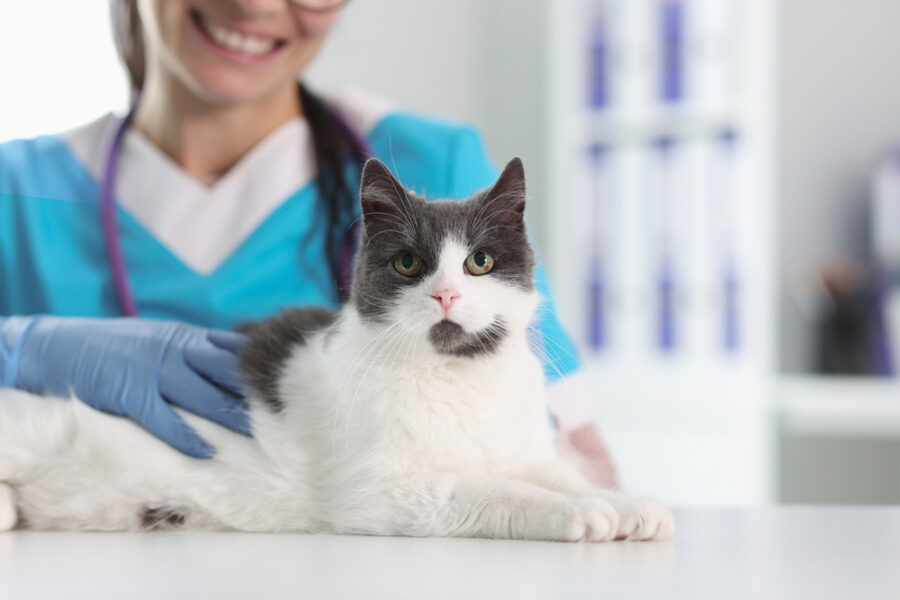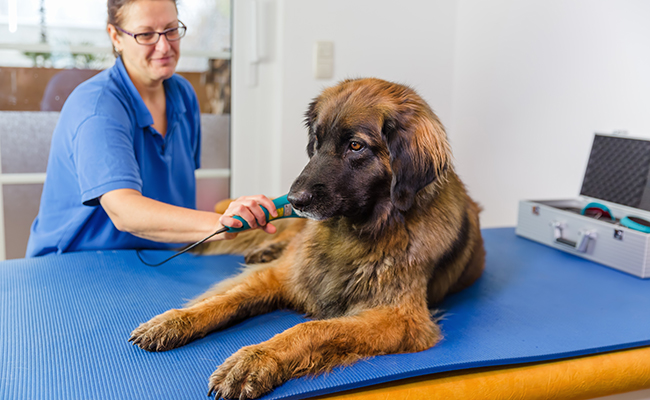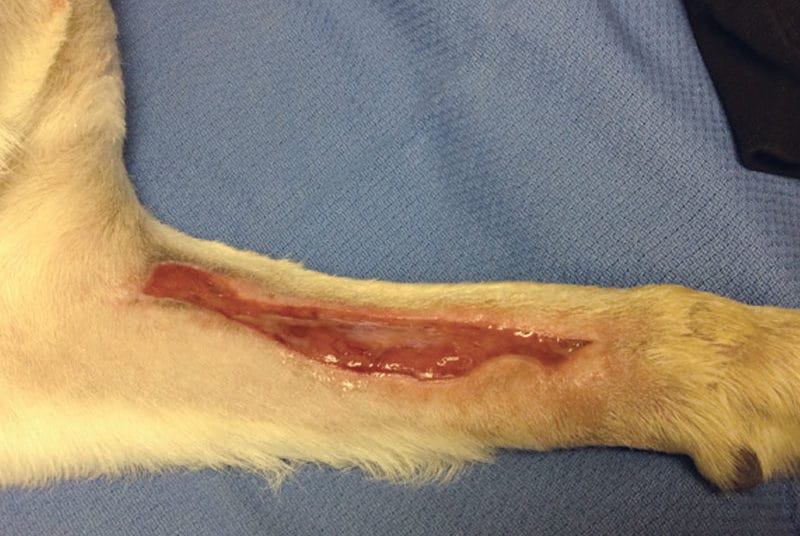PBM for veterinary dental and oral conditions is a versatile and effective tool for managing dental and oral conditions, from gingivitis to post-surgical recovery.
Photobiomodulation (PBM) therapy has emerged as a versatile treatment modality in veterinary medicine. This article explores applications of PBM for veterinary dental and oral conditions, focusing on post-dental prophylaxis, post-dental extractions, and surgical recovery. We discuss mechanisms of action along with dosing considerations, techniques for managing uncooperative patients, and insights derived from cross-species evidence.
PBM for veterinary dental and oral conditions
Dental and oral health are critical components of veterinary care. Periodontal disease affects the majority of dogs and cats by age three (AAHA, 2019). This underscores the need for effective treatment modalities to address inflammation, pain, and delayed healing and PBM for veterinary dental and oral conditions is an excellent option.
PBM therapy offers a non-invasive solution with demonstrated efficacy in both veterinary and human medicine. While studies in dogs and cats are limited, findings from human and laboratory animal research provide valuable insights for clinical application (Ross & Ross, 2009; Kalhori et al, 2019).
Mechanisms and evidence for PBM for veterinary dental and oral conditions
PBM operates at the cellular level by delivering red-to-near-infrared light (650–1100 nm) to chromophores in cells, primarily cytochrome c oxidase. This interaction enhances mitochondrial function, leading to increased ATP production, beneficial reactive oxygen species (ROS), and modulation of inflammatory pathways.
Key anti-inflammatory effects include suppression of cytokines such as TNF-α, IL-6, and prostaglandins, which are critical drivers of tissue damage in conditions like gingivitis and stomatitis (Hamblin, 2006; Watson & Brundage, 2019).
In addition to its effects on inflammation, PBM promotes tissue repair by enhancing fibroblast proliferation, collagen synthesis, and angiogenesis. These processes accelerate wound healing, restore tissue integrity, and can improve periodontal outcomes following dental surgery.
Evidence from human dentistry highlights PBM’s ability to improve gingival health and periodontal ligament repair, while rodent studies confirm its efficacy in reducing oral inflammation and promoting mucosal regeneration (Kalhori et al, 2019).
Precise dosing is essential to optimize therapeutic outcomes. Fluences typically range from 2–8 J/cm² depending on tissue depth, which in this case is usually dependent on whether or not direct access to the buccal mucosa and gingiva is possible. The mechanisms outlined here form the foundation for PBM’s application in veterinary oral health.
Applications of PBM in veterinary dentistry
- PBM significantly reduces inflammation and erythema following dental cleanings. Alves and colleagues (2023) demonstrated significantly reduced gingivitis scores over a two-week period in dogs treated with just a single session of PBM immediately after dental prophylaxis. The therapy alleviates discomfort caused by scaling and polishing, enabling quicker recovery of oral tissues.
- PBM has demonstrated significant potential in reducing pain and accelerating healing following dental extractions. In a study by Momeni et al (2022), a single session of extraoral 940 nm diode laser therapy significantly decreased pain scores in patients after mandibular molar extraction. The treated group reported lower analgesic use and experienced faster pain relief compared to the placebo group.
This trend of pain reduction highlights PBM’s efficacy in modulating inflammatory processes (Momeni et al, 2022) and is consistent with other non-dental studies in dogs in which even a single post-operative PBM session could significantly reduce pain scores in the hours after surgery (Alves et al, 2024).
In addition to PBM’s effects regarding enhanced wound healing through biostimulation of fibroblasts and modulation of inflammatory cytokines, such as IL-6 and TNF-α (Hamblin, 2006), these mechanisms reduce pain while supporting soft tissue and bone regeneration, making PBM a valuable adjunctive therapy in veterinary oral surgical care.
Techniques for cooperative and uncooperative patients
Technique is very important and involves keeping the laser beam continuously moving (unless using very low power) and allowing the tissues to thermally relax before returning to the same area.
Since patients may often be anesthetized and in recovery during these treatments, it is recommended that the laser operator use one hand/fingers to actively monitor the skin/gingival temperature in the area/field they are treating by physically touching it with their free hand (not with the hand holding the laser handpiece) and adjusting their technique (moving faster, covering a larger area) or turning the power down if the skin feels too warm.


As always, the patient’s (and operator’s) eyes should be protected with laser safe eyewear during this treatment.
For uncooperative, awake patients, extraoral treatment through the lips is possible, but will require slightly higher doses of 6–8 J/cm² to compensate for photon attenuation as the light travels through the extra layers of tissue (and possible reflection if treating in an off-contact manner).
Positioning the laser appropriately to treat the entire dental arcade, including both sides and through the intermandibular space, is essential. If the patient will allow on-contact treatment through the lips and under the jaw, that is ideal. If they will not allow on-contact treatment, the laser operator may still treat in an off-contact manner, at least until the patient is more comfortable.
Conclusion
PBM is a versatile and effective tool for managing dental and oral conditions in veterinary patients. By leveraging evidence from human and animal studies, veterinarians can optimize treatment protocols for conditions ranging from gingivitis to post-surgical recovery.
As far as PBM for veterinary dental and oral conditions is concerned, precise dosing and tailored techniques, whether intraoral or extraoral, ensure safe and effective outcomes. Continued research and clinical adaptation will expand PBM’s role in veterinary dentistry, improving care for companion animals.
References
Alves, J.C., Filipe, A., & Santos, A. (2024). Post-surgical photobiomodulation therapy improves outcomes following elective gastropexy in dogs. Lasers in Medical Science.
Alves, J.C., Jorge, P., & Santos, A. (2023). The Effect of Photobiomodulation Therapy on Inflammation Following Dental Prophylaxis. Journal of Veterinary Dentistry.
Watson, A.H., & Brundage, C.M. (2019). Photobiomodulation as an Inflammatory Therapeutic Following Dental Prophylaxis in Canines. Photomedicine and Laser Surgery.
Kalhori, K.A.M., et al. (2019). Photobiomodulation in Oral Medicine. Photobiomodulation, Photomedicine, and Laser Surgery.
Hamblin, M.R. (2006). Mechanisms of Low-Level Light Therapy. Lasers in Surgery and Medicine.
Fabre, H.S.C., et al. (2015). Anti-Inflammatory and Analgesic Effects of Low-Level Laser Therapy on the Postoperative Healing Process. Journal of Physical Therapy Science.
Arany, P.R. (2016). Craniofacial Wound Healing with Photobiomodulation Therapy. Journal of Dental Research.
Momeni, N., et al. (2022). Efficacy of Diode Laser Therapy for Pain Reduction after Dental Extractions. BMC Oral Health.
AAHA Dental Care Guidelines for Dogs and Cats. (2019). American Animal Hospital Association.








